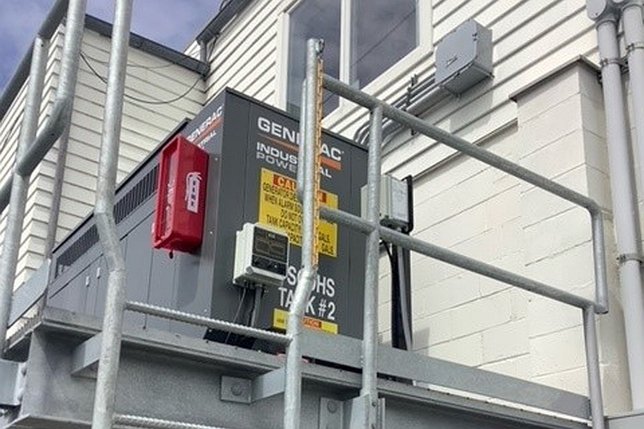The Governor’s Office of Storm Recovery (GOSR) today announced the completion of resiliency projects that will improve the Fire Island community’s response during emergencies. The projects, totaling a $3 million investment, fortified a vital emergency route and installed backup power generators.
Upgrades included:
- The western section of Burma Road, a vital access route for emergency vehicles that’s located in a 100-year flood plain, was reconstructed to withstand future flooding and erosion.
- Traffic safety conditions were improved and ditches were cleared along Burma Road.
- An emergency power generator was installed on elevated platforms in the Fair Harbor Fire Department, which is in an extreme flood risk area. The generator will be able to provide continuous power during an emergency.
- An emergency power generator was installed on elevated platforms in the Village of Saltaire Water Treatment Facility, which is also in an extreme flood risk area. The generator will be able to provide continuous power during an emergency.
These upgrades will enhance resiliency by improving critical facilities and street infrastructure. They will help facilitate evacuation in the event of an emergency, ensure first responders can operate safely and efficiently during emergencies, and guarantee a clean water supply even during storms.
GOSR Executive Director Katie Brennan said, “First responders are a critical lifeline for Fire Island and these projects will ensure that their essential infrastructure is more resilient during flooding and major storms. We will continue to support projects that strengthen resiliency and help communities adapt to climate change along the Great South Bay and across New York.”
Communities along Long Island’s Great South Bay regularly deal with flooding and storm surge. During Superstorm Sandy, waves as high as 9.6 meters and winds as fast as 90 mph caused two major breaches on Fire Island which cut the island in two. Beaches and dunes lost over half of their volume, leaving the area more vulnerable to future storms. Not only did it impact access for first responders, but the storm also flooded walkways and caused power outages. It caused damage to 1,600 homes as well as to critical infrastructure including fire houses, water treatment facilities, and vital access roads. Burma Road was flooded and the Fair Harbor and Saltaire facilities lost power.
These street and power infrastructure upgrades will improve the community’s recovery efforts during future storms.
Senator Phil Boyle said, “As both a state senator and first responder that saw the devastation that Superstorm Sandy wrought on our area, I know very well how truly vital this funding has been. There is no doubt that these resiliency projects will help protect lives and properties not only on Fire Island but also in our South Shore communities.”
"With extreme weather incidents becoming more and more common, it is more important than ever to ensure that we strengthen our shorelines and protect vital infrastructure,” said Suffolk County Executive Steve Bellone. “The completion of this project does that, while also ensuring that our first responders are able to act as quickly and safely as possible during any future emergencies.”
Hugh O'Brien, Mayor of the Village of Saltaire, said "The state's provision of an emergency generator to the Village of Saltaire, and the reconstruction of the Burma Road, not only enhance the safety of Fire Island's residents, they further confirm the critical role the island plays in the protection of the south shore of Long Island."
Alexcy Romero, Superintendent of the National Parks Service’s Fire Island National Seashore, said, “This project is great example of how the Federal Highway Administration, National Park Service, Governor’s Office of Storm Recovery, Suffolk County and the neighboring communities worked together to achieve this much-needed project. It took collaboration to complete this road improvement project at Fire Island National Seashore!”
“The Burma Road Improvement Project truly has had a positive effect on emergency response to and from Fire Island Pines. We are able to better offer our neighbors to the west a quicker response during all emergencies and we are able to receive mutual aid to Fire Island Pines from our neighbors more efficiently. Thank you to GOSR for a job well done,” said Fire Island Pines Fire Department Chief Joe Geiman.
“The Fair Harbor Fire District is grateful for the infrastructure improvements made on the western portion of Fire Island by the Governor’s Office of Storm Recovery. The installation of generators at the Fair Harbor and Saltaire Firehouses as well as the reconstruction of the Burma Road will greatly improve our emergency response capabilities in the event of future natural disasters,” said Kathleen Chinkel of the Fair Harbor Fire District.
About GOSR
Established in June 2013, GOSR coordinates statewide recovery efforts for Superstorm Sandy, Hurricane Irene, and Tropical Storm Lee. More recently, GOSR is also coordinating recovery and resiliency efforts for Hurricane Ida. Through its NY Rising Housing Recovery, Small Business, Community Reconstruction, Infrastructure, and Rebuild by Design programs, GOSR invests $4.5 billion in federal Community Development Block Grant-Disaster Recovery (CDBG-DR) funding to better prepare New York for extreme weather events. The agency is also leveraging Community Development Block Grant-Coronavirus (CDBG-CV) funds to implement resiliency initiatives More information about GOSR and its programs is available at http://stormrecovery.ny.gov/.
Through the NY Rising Community Reconstruction (NYRCR) and Infrastructure Programs, the State takes on a variety of initiatives developed during its bottom-up community planning process to improve resiliency, protect critical infrastructure, mitigate the risks of loss and damage associated with future disasters, and reduce hardship. Now in the implementation stage, GOSR works with a variety of municipal, county, and non-profit partners to bring hundreds of locally devised proposals to fruition.










